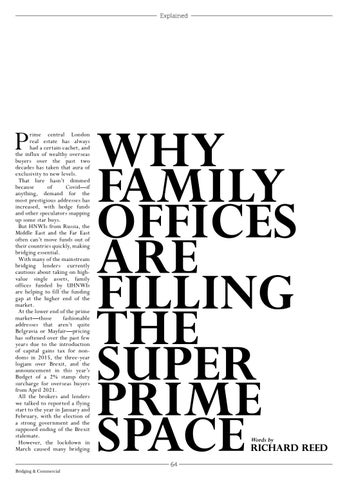Explained
P
rime central London real estate has always had a certain cachet, and the influx of wealthy overseas buyers over the past two decades has taken that aura of exclusivity to new levels. That lure hasn’t dimmed because of Covid—if anything, demand for the most prestigious addresses has increased, with hedge funds and other speculators snapping up some star buys. But HNWIs from Russia, the Middle East and the Far East often can’t move funds out of their countries quickly, making bridging essential. With many of the mainstream bridging lenders currently cautious about taking on highvalue single assets, family offices funded by UHNWIs are helping to fill the funding gap at the higher end of the market. At the lower end of the prime market—those fashionable addresses that aren’t quite Belgravia or Mayfair—pricing has softened over the past few years due to the introduction of capital gains tax for nondoms in 2015, the three-year logjam over Brexit, and the announcement in this year’s Budget of a 2% stamp duty surcharge for overseas buyers from April 2021. All the brokers and lenders we talked to reported a flying start to the year in January and February, with the election of a strong government and the supposed ending of the Brexit stalemate. However, the lockdown in March caused many bridging
WHY FAMILY OFFICES ARE FILLING THE SUPER PRIME SPACE Words by
richard reed
64
Bridging & Commercial
